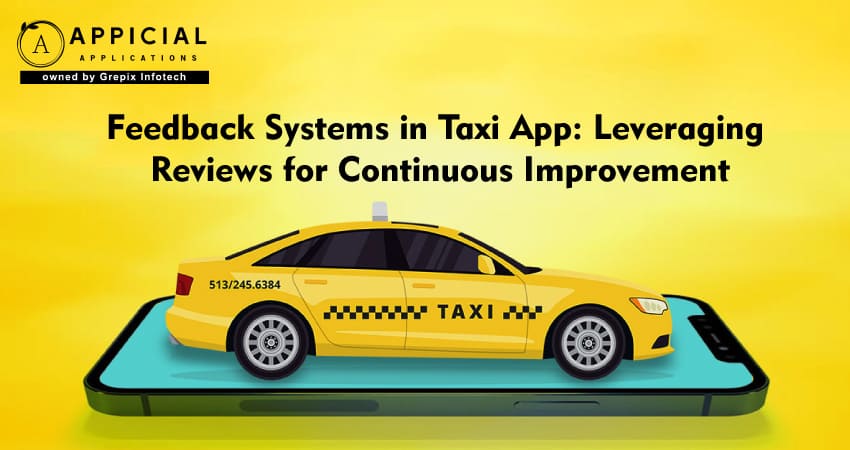
Feedback Systems in Taxi App: Leveraging Reviews for Continuous Improvement
In the fast-paced world of ride-hailing services, customer satisfaction isn't just a metric, it's the lifeblood of the business. As the taxi industry becomes increasingly competitive, companies are continually seeking ways to differentiate themselves and provide unparalleled service. One of the most effective strategies for achieving this is robust feedback systems within taxi apps. By leveraging reviews, companies can foster continuous improvement, enhance user experience, and build a loyal customer base. In this comprehensive guide, we'll delve into the significance of feedback systems in taxi apps and how they serve as catalysts for growth and excellence.
In the competitive ride-hailing industry, customer satisfaction is crucial, making effective feedback systems within taxi apps essential for ongoing improvement. By leveraging reviews, companies can enhance user experience, optimize services, improve driver performance, and gain a competitive edge. Effective feedback mechanisms include post-ride ratings, in-app surveys, customer support channels, driver feedback, and data analytics. Strategies to maximize their effectiveness involve simplifying the feedback process, encouraging honest input, acting promptly on feedback, closing the feedback loop, leveraging technology, and training staff accordingly. Implementing best practices ensures companies stay connected to customer needs, fostering growth and excellence in their services.
The Imperative of Feedback in Taxi Services
Feedback is more than a collection of comments and ratings; it's a treasure trove of insights that can steer a company toward success. In the context of taxi apps, feedback systems play a pivotal role in:
- Quality Control: Identifying areas where services are excelling or falling short.
- Customer Retention: Addressing issues promptly to keep customers satisfied.
- Driver Performance: Monitoring and improving driver behavior and professionalism.
- Innovation: Gaining ideas for new features or services that customers desire.
Without an effective feedback mechanism, taxi companies risk becoming disconnected from their customers' needs and expectations, leading to declining satisfaction and, ultimately, a loss of market share.
How Feedback Systems Work in Taxi Apps
Feedback systems in taxi apps are typically multifaceted, encompassing various tools and methodologies to collect and analyze customer input. Here's how they generally function:
1 Post-Ride Ratings and Reviews
After each ride, customers are prompted to rate their experience on a scale (usually 1 to 5 stars) and provide written comments. This immediate feedback captures the customer's fresh impressions.
2 In-App Surveys
Occasionally, apps may include more detailed surveys to gather specific information about different aspects of the service, such as vehicle cleanliness, driver courtesy, and app usability.
3 Customer Support Channels
In-app chat, email support, or helplines allow customers to report issues or provide suggestions outside the standard rating system.
4 Driver Feedback
Drivers can also rate passengers and provide feedback, creating a two-way communication channel that fosters mutual respect and safety.
5 Data Analytics
Advanced analytics tools process the collected data to identify patterns, trends, and areas requiring attention, facilitating informed decision-making.
The Benefits of Leveraging Reviews for Continuous Improvement
Harnessing the power of customer reviews can yield significant advantages for taxi app companies:
1 Enhanced Customer Experience
By actively responding to feedback, companies can tailor their services to meet customer expectations, leading to increased satisfaction and loyalty.
2 Improved Driver Performance
Feedback highlights exemplary drivers and those needing improvement. Companies can reward high-performing drivers and provide additional training or corrective measures for others.
3 Service Optimization
Analyzing feedback helps identify common issues such as long wait times, app glitches, or route inefficiencies, enabling companies to refine their operations.
4 Brand Reputation Management
Publicly addressing feedback demonstrates a company's commitment to customer satisfaction, enhancing its reputation, and attracting new users.
5 Competitive Advantage
Companies that effectively leverage feedback are better positioned to innovate and stay ahead of competitors by continuously improving their offerings.
Also Read: The Future of Mobility: Predictions for the Next Decade
Strategies for Effective Feedback Systems
Implementing a feedback system is not just about collecting data; it's about creating a process that leads to actionable insights and tangible improvements. Here are strategies to maximize the effectiveness of feedback systems in taxi apps:
1Simplify the Feedback Process
- User-Friendly Interface: Ensure the feedback mechanism is easy to use and accessible immediately after the ride.
- Minimal Steps: Reduce the steps required to submit feedback to encourage higher participation rates.
2Encourage Honest Feedback
- Anonymity Options: Allow users to submit feedback anonymously to promote honesty without fear of repercussions.
- Incentivization: Offer small rewards or loyalty points for providing feedback to increase engagement.
3Act on Feedback Promptly
- Real-Time Alerts: Set up systems to notify relevant departments of critical feedback requiring immediate attention.
- Follow-Up Communications: Reach out to customers who have reported issues to inform them of the actions taken.
4Close the Feedback Loop
- Transparency: Share with customers how their feedback has led to improvements or changes in the service.
- Regular Updates: Provide updates on new features or policy changes that resulted from customer input.
5Leverage Technology
- Artificial Intelligence: Utilize AI and machine learning to analyze large volumes of feedback quickly and identify significant patterns.
- Sentiment Analysis: Implement tools that gauge customer sentiment to prioritize issues affecting satisfaction levels.
6Train Staff Accordingly
- Driver Training Programs: Use feedback to develop targeted training sessions for drivers.
- Customer Service Training: Equip customer support teams with the skills to handle feedback professionally and empathetically.
Case Studies: Success Through Feedback
1 Uber's Two-Way Feedback System
Uber revolutionized the taxi industry with its two-way feedback system, where drivers and passengers rate each other. This system has been crucial in maintaining quality and safety standards. Drivers with low ratings receive warnings or additional training, while passengers exhibiting problematic behavior may face account suspension.
2 Lyft's Focus on Driver Recognition
Lyft places a strong emphasis on recognizing and rewarding top-performing drivers based on customer feedback. This strategy has led to higher driver satisfaction and better customer experiences, as drivers are motivated to provide exceptional service.
3 Grab's Real-Time Feedback Response
Grab, a leading ride-hailing service in Southeast Asia, utilizes real-time feedback alerts to address issues immediately. If a ride receives a low rating, the customer support team reaches out to the passenger to resolve the issue promptly, often within minutes of the ride's completion.
Best Practices for Implementing Feedback Systems
To maximize the benefits of feedback systems, taxi app companies should adhere to best practices that ensure the process is efficient, respectful, and productive.
1 Respect Privacy and Data Security
Protecting user data is paramount. Ensure that all feedback is handled in compliance with data protection laws and that the user's personal information is secured against unauthorized access.
2 Avoid Feedback Fatigue
While collecting feedback is important, overloading users with requests can lead to annoyance and reduced participation. Balance the frequency of feedback requests to maintain engagement without causing fatigue.
3 Be Proactive, Not Reactive
Don't wait for negative feedback to make changes. Regularly analyze trends and anticipate potential issues before they escalate, demonstrating a commitment to continuous improvement.
4 Integrate Feedback Across Departments
Feedback should inform not just customer service but all relevant departments, including operations, marketing, and product development, to foster a cohesive approach to enhancement.
5 Celebrate Positive Feedback
Acknowledge and reward not only the staff involved but also share positive stories with the broader team to boost morale and reinforce the behaviors that lead to customer satisfaction.
The Future of Feedback Systems in Taxi Apps
As technology advances, feedback systems are poised to become even more sophisticated. Emerging trends include:
- Voice and Video Feedback: Allowing users to submit voice notes or video messages for a more personal touch.
- Predictive Analytics: Anticipating customer needs and potential issues before they arise.
- Integration with Social Media: Expanding feedback channels to include social platforms where customers are already active.
- Gamification: Making the feedback process engaging by incorporating game-like elements to encourage participation.
By staying ahead of these trends, taxi app companies can continue to refine their services and maintain a competitive edge.
Conclusion
Feedback systems are an indispensable component of modern taxi apps, serving as the bridge between the company and its customers. By effectively leveraging reviews and feedback, companies can achieve continuous improvement, resulting in enhanced customer satisfaction, better driver performance, and a stronger market position.
Appicial Applications a leading taxi app development company, understands the transformative power of feedback systems. Our taxi app solutions are designed with robust, customizable feedback mechanisms that not only collect valuable data but also translate it into actionable insights. We are committed to helping taxi businesses harness the full potential of customer feedback to drive excellence and innovation.
Investing in a sophisticated feedback system is not just a strategic choice; it's a commitment to your customers and your company's future. Embrace the power of feedback, and let it propel your taxi app to new heights of success.
Looking out to start your own venture like Uber? Try out our HireMe Uber Clone, the easiest way to kick-start your taxi business.






